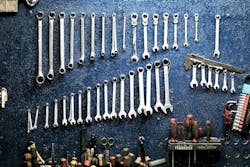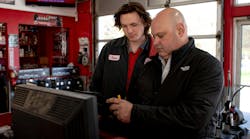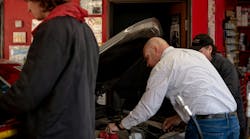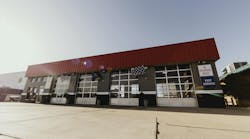In the 1971 tune “Signs,” performed by the Canadian rock group Five Man Electrical Band and written by Les Emmerson, the central chorus lines pound out the still resonating lyrics:
“Sign, sign, everywhere a sign. Blockin’ out the scenery. Breakin’ my mind. Do this. Don’t do that. Can’t you read the sign?”
While the tune was written 43 years ago about social intolerance and exclusion, those lyrics are a perfect fit for the experience I had on a visit to a local fast lube.
While I was seated in the waiting room, another customer — an older lady who was probably near 70 years old — was waiting for her vehicle and asked me, “Doesn’t sitting in this waiting room make you tired?” Curiously, I asked her, “What do you mean?” She responded, “There are so many different signs and brochures. My eyes can’t rest! Each different sign is recommending a different service that my car needs. I’m wondering, do I really need to have all these things done to my car? What do you think?”
I won’t go into how I responded to her question, but as I looked around that waiting room and thought about her concerns, the words from that 1970s tune came to my mind. She was correct. There were brochures on counters, posters on walls and even one hanging from the ceiling!
In this column, we will consider the concerns expressed by that customer and the use of point-of-sale (POS) displays. POS displays are intended to draw the customers’ attention to products, services, promotions or any other information a store wants to make known to the customer. They can include signs, posters, brochures, bay banners and curb stands.
A POS display in your fast lube is the most uninterrupted form of visual communication you can use. In fact, because POS displays are such a universally accepted form of communication, we tend to use them without giving their purpose anymore thought than, “I think we need to let people know about…” We put up a POS display devoted to whatever we feel needs to be made known. When we can’t or don’t want to talk to other people directly, we stick up a sign that reads, “No customers allowed in bay area!” If that doesn’t work, we put up bolder sign reading, “No customers allowed in the bay area!” If that doesn’t work, we put up numerous signs with the same message.
A mistake often made when it comes to the use of POS displays is believing they will change or affect a person’s behavior in a meaningful way. If POS displays actually did that, everyone would stop at every stop sign, poster and banner. Everyone would always turn off their cell phones in a movie. Every customer would purchase the services you promote through POS in your waiting room. Since we know none of those things actually happen, the questions we should be asking about our use of POS displays are these: What is the realistic role of POS in my fast lube? How much information is too much for my customers? Does the use of POS create trust and positive customer response to offers?
When compared to the cost of advertising in some other media, waiting room POS is very inexpensive. There is probably no better advertising dollar value than your waiting room signs, posters, brochures etc. But it’s probably for that reason waiting room displays can be overdone and draw the response, “My eyes never get to rest.”
Because your customers spend time in your waiting room, their feelings about your fast lube are dramatically affected by what they read, feel, hear, smell or experience while they wait. That being the case, the way you elect to utilize POS displays to promote products and services should be carefully planned with your customers in mind.
Consider the following shortlist of POS options that are often displayed in or near a fast lube waiting area: curb stands, posters, countertop displays, banners, brochure holders, floor graphics, menu boards, window clings, and TVs displaying videos and other relevant info.
When you consider that list of POS options to promote products, services and promotions, it’s no wonder some customers feel overwhelmed and even a bit exhausted by the time their vehicle service is completed. So how can POS displays be better utilized to promote products and services in a more customer friendly way?
One way to help clear out the clutter in your waiting room and allow your customers to have some peace while still being made aware of your products and services is by utilizing digital display options such as TVs.
Some of the advantages of digital displays include: cleaning up your waiting room, providing promotions of numerous messages in one place, being noticeable but not overwhelming, are easy to update and are likely more appealing than worn out physical POS displays. Perhaps most importantly, digital displays appeal to the growing generation of millennials, who are the first generation of digitally-based shoppers. According to data in an online study, as many as 38 percent of millennials are influenced by in-store POS compared with 28 percent of the general population.
Digital POS is not only a good way to clean up the avalanche of POS displays in your waiting room, it’s also an efficient way to reach the new generation of customers, who according to the study, spend $400 billion annually and will account for one-third of all retail spending by 2020.
Large floor space retailers perform POS display saturation analysis, a process where they learn more about the impact of POS display quantity in a store and what to do about it. This is based on the ability of customers to recall advertising messages viewed in the actual store environment, as it exists, versus what they recall in views where successive layers of POS displays have been peeled away. These studies are designed to determine if removal of clutter improves recall and resulting sales.
I realize it’s unlikely you will undertake the process of performing this type of analysis for your waiting room. However, the point is customers can only take in so much information before they simply decide to shut down and block out everything. I suggest this is a good caution to keep in mind before you decide to tack up another poster or banner.
There are probably not too many customers who actually voice their concerns like the woman in the waiting room did, but I will tell you how I feel when I sit in the midst of a barrage of posters, brochures and banners. I can tell you without question that all of the waiting room POS combined does not usually cause me to spend more than I had planned to spend on servicing my car. While POS displays play their part to inform me, the single factor that affects my spending choices most often is the personal advice received from a trusted service professional about what my vehicle actually needs.
Whichever approach you decide to take when it comes to the POS displays you place in and around your fast lube, remember trust and value are always at the heart of a decision to buy. POS displays don’t create trust; knowledgeable, reliable people do.
PAUL HALOULOS is a trade marketing manager for BP Lubricants USA, Inc. He may be reached at: [email protected]. To learn more about Castrol products and programs in general, please call 888.CASTROL or visit: www.castrol.com/installers





